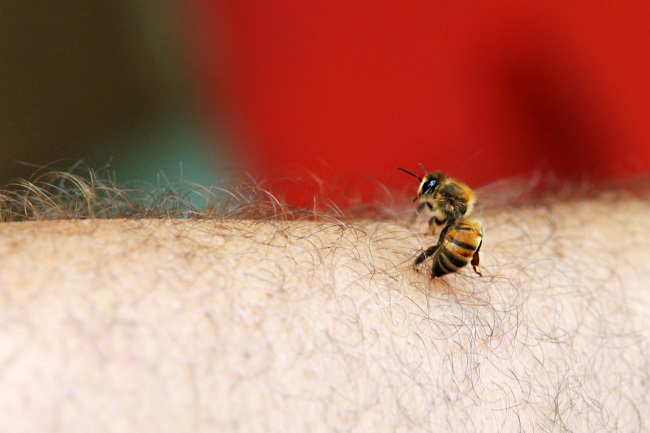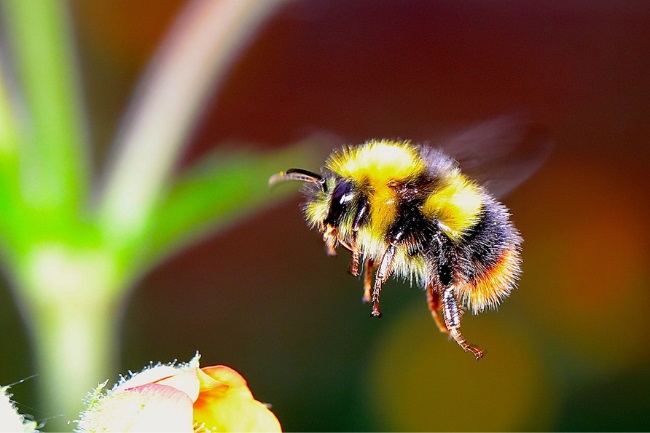All bumblebee females have a stinger, which is an ovipositor that has evolved to become a defensive weapon. Males do not have stingers and cannot sting; however, even females rarely sting and are very passive.
Contents
What is a stinger?

A stinger is a long, sharp, needle-like protrusion at the end of the bee’s abdomen. Only female bees have stingers, as they are thought to have evolved from the ovipositor that females use to lay eggs.
The stinger is hollow and connected to a venom sack. When bees sting, this venom is pushed down into the skin of the creature they are stinging, releasing the toxic cocktail. It’s the venom that causes the majority of the discomfort and pain, as it includes chemicals that cause cells to break down.
Most of the swelling is caused by our antibodies fighting back and trying to prevent the spread of the venom, this itself causing us discomfort.
| Insect | Sting Characteristics |
|---|---|
| Bumblebee | Bumblebee stings are generally less painful and milder compared to bees or wasps. They are typically not aggressive but can sting if provoked or threatened. |
| Honeybee | Honeybee stings are generally painful and can leave a stinger behind. They can only sting once and then die. |
| Yellowjacket Wasp | Yellowjacket wasp stings are painful and can cause an allergic reaction in some individuals. They are more aggressive and can sting multiple times. |
| Paper Wasp | Paper wasp stings are painful and can cause a localized reaction. They are generally not as aggressive as yellowjacket wasps. |
| Hornet | Hornet stings are painful and can cause severe allergic reactions in some cases. They are generally more aggressive than bumblebees or wasps. |
Although only female bees have stingers, it’s worth remembering that the majority of the bees we see are female, with drones only being produced to fertilise the queens, meaning they are needed in much smaller numbers than the workers.
Bumblebees are much less inclined to sting than honeybees. This may be in part because honeybees have had to be more defensive of their hive, as many other species like to raid their homes for the tasty honey and larvae found within.
As bumblebee hives are much smaller and contain only a small amount of honey and fewer larvae, they may have experienced lower levels of predation, and therefore feel less defensive of intruders.
That being said, bumblebees will defend their hives or themselves from harm if necessary. This doesn’t mean you need to be scare of every bumblebee that comes buzzing by, however. The majority are just out on a food shop, more interested in nearby flowers than in you.
Also read: What Bees do NOT Sting? (A List Of Species Included)
How to prevent being stung?

As with all wild animals, there’s often something which we have done to cause an attack. These are often things we have carried out unknowingly, such as wandering near a nest or accidentally standing on a feeding bee.
There’s always an element of bad luck, but if we can be more aware of wild animals and what triggers them to attack, we can considerably reduce uncomfortable occurrences.
With bees, there are two leading causes of stings; threatening a nest or threatening an individual.
When it comes to bee nests, the best action is to avoid them. Bumblebee hives are often on the ground, in old nests of small mammals or in the soil. Sometimes they will set up home in artificial habitats, such as in cavities within buildings or in log piles.
A clear sign that there is a nest is if large numbers of bees are flying around a hole or entrance. With bumblebees, this may only be five to ten individuals. Listen out for buzzing sounds to indicate there might be a group of bees around, and look out for individuals flying around in one location.
If you find a bumblebee nest by accident, step away and leave it be. If it has to be moved for health and safety reasons, get an expert who knows what they are doing. Bumblebees are very passive and important pollinators. If you can leave them where they are, it can be very rewarding to watch them work and understand more about their lifecycle.
| Bumblebee Species | Sting Characteristics |
|---|---|
| Common Eastern Bumblebee | Bumblebees have a stinger, and the sting is generally mild. They are not as aggressive as some other stinging insects. The stinger is used for defense. |
| Garden Bumblebee | Bumblebees have a stinger and can deliver a sting if they feel threatened. However, their stings are usually not as painful as those of other bees or wasps. |
| Buff-tailed Bumblebee | Bumblebees have a stinger but are generally not aggressive. They will sting only if they perceive a threat. The sting may cause mild pain and discomfort. |
| Red-tailed Bumblebee | Bumblebees have a stinger, but their stings are typically not very painful. They usually sting only when provoked or their nest is threatened. |
Nests will die off in the winter, and the bees will set up shop elsewhere next year, so you won’t have to leave the area untouched for long.
For individual bees, they are unlikely even to notice you unless you start trying to swat or touch them. Though it is possible to hold a bumblebee without it stinging you, such as allowing one to climb onto your hand so you can take it out of the house, the more you try to directly interact with the bee, the more likely you will scare it into stinging you.
Another common cause of stinging is stepping on bumblebees with bare feet. If you are walking around an area when lots of bumblebees are feeding, a simple solution is to wear shoes or be very careful where you step.
Also read: What to do if You’re Stung by a Bee (& How to Get Sting Out)?
Can a bumblebee sting more than once?

Most bees can sting more than once. It is only the honey bee that loses its sting and dies. This is because the honey bee’s sting is hooked. This hooked design is helpful for stinging invertebrates, which are some of the honeybees main predator species.
However, when they sting mammals, the hooks get stuck in the skin, and they are forced to pull off part of their abdomen in order to escape, which leads to their death.
Bumblebees, and other bee species, have straight stingers. This means they can sting multiple times without dying. Most bees will sting either to defend their nest or to defend themselves. Yet, bumblebees are, in general not aggressive, and do not choose to sting humans unless they are being threatened.
Some bumblebee species can be more aggressive than others, though, with the tree bumblebee, in particular, being known for being more likely to sting than others. This may also be because the tree bumblebee has developed a habit of nesting in human environments, such as in lofts or in bird boxes. Therefore humans are more likely to attempt to move or destroy their nests, which would make any bee angry and upset.
Also read: Do Cicada Killers Sting? Does it Hurt or is it Dangerous?
What does a bumblebee sting look like?

A bumblebee sting looks like other insect stings. You are unlikely to find the stinger itself embedded in your skin, as it will still be attached to the bumblebee. What you will see is a pale circle with a red pinprick in the middle.
Over time this will likely swell and become red. The pain and swelling is short-lived for most people, though some people may experience an allergic reaction. Like other bee stings, this allergic reaction can be severe, including swelling elsewhere on the body or an anaphylactic shock.
Also read: What do Bumblebees Eat and Drink? (Habits Explained)
How painful is a bumblebee sting?
A bumblebee sting certainly isn’t a fun thing, and most people aren’t going to be keen to get stung. However, the good news is it isn’t as painful as a wasp sting and doesn’t last very long. The painful sensation is likely to stay around ten minutes, while symptoms may last up to two hours.
How to treat the sting
Like all insect stings, you will have a different treatment process if you are allergic. If you’re allergic, you may need to administer an EpiPen or go to the hospital. For those that aren’t allergic, you can remove any stinger that remains in place and possibly take an antihistamine.
Applying ice within a tea towel can help with the swelling, as can some over the counter creams. Mainly it’s a waiting game till the pain eases and self-control to interact with the bee directly, not to scratch the area, which could lead to infection.
Also read: Do Grasshoppers Bite or Sting? Can it Hurt Humans?
Attack of the bees?
Bees, in general, are not very interested in us humans. They have more important things to be getting on with. Unfortunate accidents may occasionally occur. However, most of the time, if you respect a bee’s personal space you shouldn’t have a problem.

